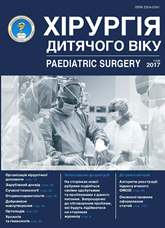Orthopedic correction of pronation foot deformities in children with cerebral palsy
DOI:
https://doi.org/10.15574/PS.2017.54.58Keywords:
pronation foot deformity, cerebral palsy, serial castingAbstract
Objective. Development of methods for orthopedic correction and evaluation of their efficacy, depending on the options of pronation foot deformities in children with cerebral palsy.
Material and methods.The data obtained during the orthopedic treatment of 36 patients aged from 1 year to 7 years with pronation foot deformities on the background of cerebral palsy. Survey method involves determining the height of the longitudinal arch, plantography, deviation angle of the heel bone in the sagittal and frontal planes, X-ray examination.
Results and conclusions. Correction of pronation deformities included the ankle-foot cast application for the gradual elimination of the certain elements of deformation. During the treatment of the first pronated foot type, we managed to correct the equinus foot deformity, grade I, in children under the age of 2.5 years. In other cases, we could not manage to achieve the correct heel bone position, even after the repeated serial casting. Failure of repeated serial casting had a negative impact on the formation of longitudinal arch of the foot. In the case of orthopaedic treatment of the second pronated foot type, alongside with both a flexible foot and the intact tarsal bones, we managed to achieve the correct bones shape. Under the condition of the rigid foot and the deformed tarsal bones, the prolonged plaster and splint immobilization were needed. In the course of treatment of the third deformation type, a positive effect was achieved on condition that the physiological calf muscle retraction was restored and the pathological tone of the m. tibialis anterior and musculi extensoris digitorum was eliminated. The negative factor were the gross anatomical abnormalities in the tarsal bones. However, orthopaedic treatment of the third variant of strain, grade II-III, carried out as preoperative preparation that permitted to limit the scope of surgical intervention.
References
Danylov OA, Horelik VV, Kysylenko AS et al. 2005. Kompleksne likuvannia ploskovalhusnykh deformatsii stop u ditei z tserebralnym paralichem. Ortopediia, travmatolohiia i protezuvannia. 2: 34–57.
Krasnov AS. 2011. Hirurgicheskoe lechenie ekvinusnoy deformatsii stop u detey s detskim tserebralnyim paralichom (Obzor). Saratovskiy nauch-med zhurn. 7; 3: 699–703.
Ryizhikov DV. 2011. Hirurgicheskaya korrektsiya ekvinoploskovalgusnoy deformatsii stop u detey z detskim tserebralnyim paralichom. Avtoref dis. Novosibirsk.
Syichevskiy LZ, Anosov VS, Marmash AT. 2000. Rezultatyi hirurgicheskogo lecheniya ekvinovarusnyih deformatsiy stop u bolnyih detskim tserebralnyim paralichom. Zhurnal Grodnenskogo gosudarstvennogo meditsinskogo universiteta. 2: 213–217.
Krogt MM, Doorenbosch JJ et. al. 2010, Jul. Dynamic spasticity of plantar flexor muscle in cerebral palsy gait. J Rehabilit Medic. 42(2): 656–663. https://doi.org/10.2340/16501977-0579; PMid:20603696
Kay RM. 2008. Lower extremity surgery in children with cerebral palsy gait. Master techniques in orthopedic surgery in Pediatrics: 83–119.
Nowarcheck TF. 2010. Trost examination of the child with cerebral palsy. Orthoped Clin Amer. 4: 469.
Danylov OA, Shulga OV, Gorelik VV, Abdalbari J. 2016. The mechanism of formation and clinical course of pronation foot deformity in children with the cerebral palsy. Surgery of Ukraine. 4(60): 18–23.
Downloads
Issue
Section
License
The policy of the Journal “PAEDIATRIC SURGERY. UKRAINE” is compatible with the vast majority of funders' of open access and self-archiving policies. The journal provides immediate open access route being convinced that everyone – not only scientists - can benefit from research results, and publishes articles exclusively under open access distribution, with a Creative Commons Attribution-Noncommercial 4.0 international license(СС BY-NC).
Authors transfer the copyright to the Journal “PAEDIATRIC SURGERY.UKRAINE” when the manuscript is accepted for publication. Authors declare that this manuscript has not been published nor is under simultaneous consideration for publication elsewhere. After publication, the articles become freely available on-line to the public.
Readers have the right to use, distribute, and reproduce articles in any medium, provided the articles and the journal are properly cited.
The use of published materials for commercial purposes is strongly prohibited.

